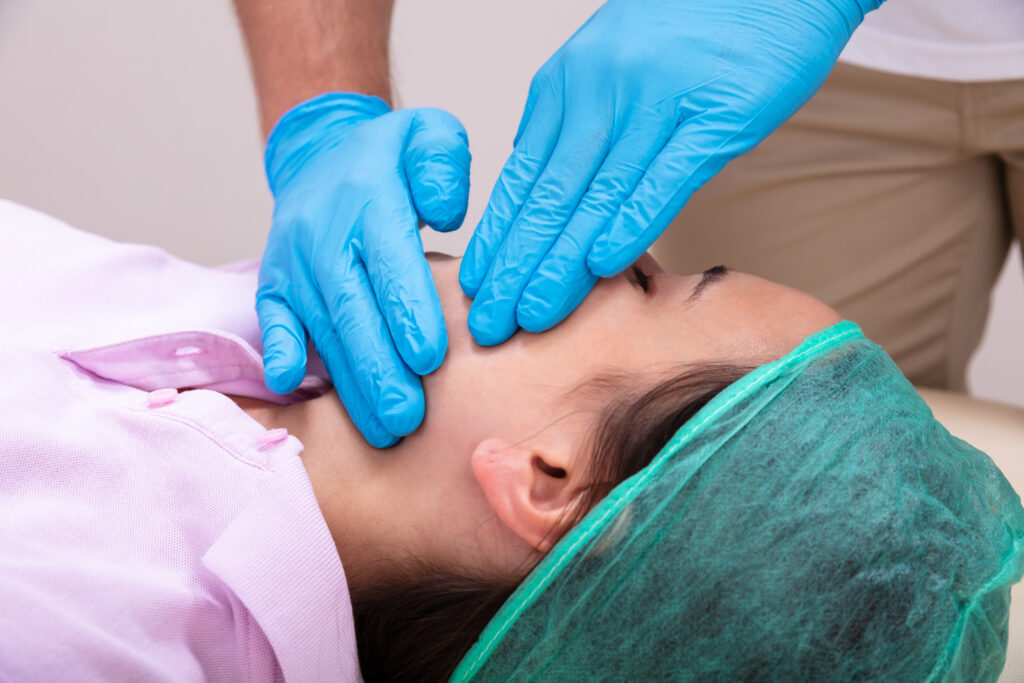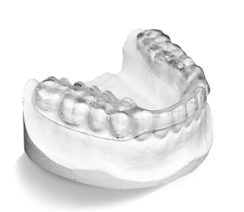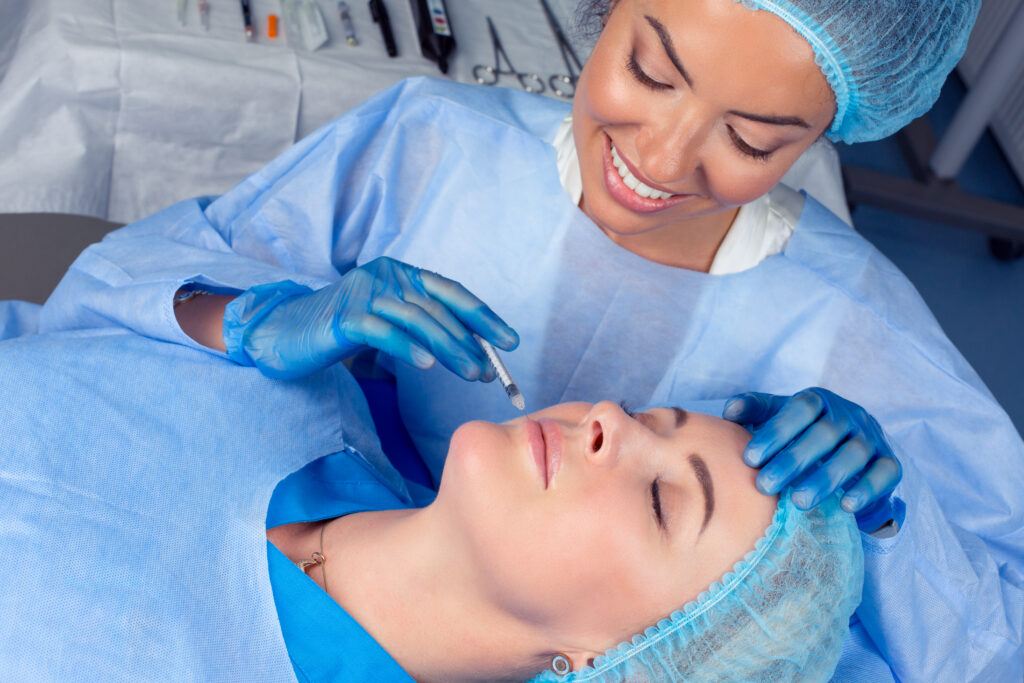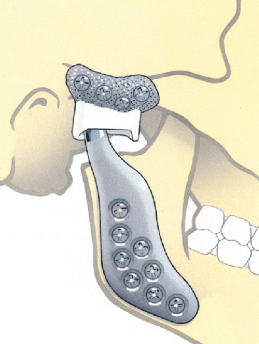When it comes to treating your jaw joint problems, it all begins with a careful diagnosis of your condition. Treatments range from stretches to surgeries and more than a dozen places in between.

We begin by discovering where you are on the path of troublesome transformation from a healthy jaw joint to a painful or poorly working TMJ joint.
Once we know where you are, we can determine the best course of action. Often, the first step is to stop the progression. Treatments range from non-invasive to invasive to surgical.
Invasive procedures such as injections and surgically replacing parts of your jaw joint have a time and place. Still, it is the philosophy of Dr. Cairns to begin treatment in a non-invasive and conservative manner first. When it comes to the jaw joint invasive procedures, all have risks, and if we can get you 90% better with minimal risks, we begin there.
The following is a brief review of the range of treatments and when we might choose that treatment. I apologize that this post is both longer than I would like and not extremely detailed on any of the options for care, but it does represent a large swath of TMJ treatment options.
Massage Therapy, Physical Therapy/Chiropractic, & Cold Laser

Massage Therapy: Who doesn’t feel better after a massage- Massage therapy is excellent at breaking up knots in muscles.
Physical Therapy: PT is a combination of stretching and massaging muscles that are spasming or have shortened and are limiting your range of motion. Some limitations of the range of motion come from the cartilaginous disc slipping between the two bones of your jaw joint getting displaced, not from the muscles, so PT alone will not always solve problems such as an inability to open wide or close completely.
Chiropractic Care: Chiropractors are trained in the manipulative treatment of misaligned joints. Some patients experience relief from the symptoms of TMJ pain with chiropractic care.
Cold Laser: Cold laser works in some situations by hyper charging your body’s natural healing mechanisms, increasing oxygenation, and cellular metabolism. In certain situations this increases healing time and decreases pain.
Medications & Behavioral Management

Medications: Take a pill, and the pain goes away. Medications are great at managing acute short-lasting problems. We generally use two types of medications; muscle relaxants and pain medications. Unfortunately, drugs almost exclusively mask the problem by making you less aware that it hurts. Masking pain for an extended amount of time can lead to long-term damage that otherwise might have been more easily treated if treatment was initiated earlier. Pain is an alarm that something is wrong. In my experience, treating the cause of the pain is much more successful than just managing the pain and inflammation. Muscle relaxants can undoubtedly help the acute phase of some TMJ problems. We have to be cautious and be aware of the negative effect of masking the underlying problem.
Behavioral Management
Stress: Most people have been told stress creates tension in muscles and might be the cause of their problems. Stress negatively affects your health as it increases cortisol levels in your body, and it may play a minor role in your jaw, so if it is possible to decrease stress, we should seek out ways to do this. It has been my experience that it is easy to say you should lower your stress, and it is another thing to accomplish this goal.
Daytime Clenching: Clenching and grinding of teeth likely damage the jaw joint by increasing pressure in muscles and the jaw joint complex. Putting a halt to clenching and grinding is hard. If it happens during the day, we have some ways of helping you. If it happens while sleeping, it is likely due to a decrease in oxygen levels in your bloodstream, which we should attempt to discover.
Splints

Splints/Orthotics: Splints work by doing a few different things.
- Preventing your jaw from squeezing the disc.
- Position your jaw in a place where the disc will reposition itself on the bone and not slip off as often.
- Teach you how to keep your lips together and your teeth apart (the 1% occlusion).
- Relax and quiet overactive muscles.
- Prevent your jaw from slipping into an unhealthy position.
There are dozens of designs for splints because of the multiple approaches to consider. The selection of a splint design and a prescribed time to wear a splint depends on the type of TMJ problem we are trying to solve.
Invasive Procedures from Least Invasive to Most Invasive
Non-medicated Injections (Acupuncture/Dry Needling): Non-medicated injections work by creating an inflammatory response to the site of injection, which increase blood flow to the area and stimulates the body to try and heal the area.

Medicated Muscle Injections (Trigger Point and Botox): Medicated injections either numb, reduce inflammation, or temporarily decrease the power of the muscle to contract.
Joint Space Injections or intra-articular injections (PRP, Supartaz {HA}, Stem Cell): Joint Space Injections work by using hydraulic pressure to reposition the disc when it has been dislocated. Because fluid can not be compressed, merely introducing a specific volume of fluid into an enclosed space can cause the disc to be freed up and allow it to move back into its normal position. Joint Space Injections with medications or stem cells from your own body can be introduced into the joint space to create a more stable scaffolding to allow the patient to better live “off the disc” when unable to successfully unlock the disc through other modalities.
Pressurized injections to break up adhesions (arthrocentesis): Arthrocentesis is a procedure performed under sedation. The joint capsule is punctured, and then the sterile fluid is pushed with pressure into the jaw joint complex to break up any adhesions to allow the dentist to recapture the disc through appliance therapy and to maintain the disc in its ideal position.
Surgical Replacement or Reattachment of the disc: In some patients, when other less invasive procedures cannot achieve an acceptable range of motion, it is sometimes appropriate to attempt reattaching the disc surgically or replacing the disc with something new.

Surgical Replacement of the jaw joint complex: In the most severe cases of long-standing TMJ dysfunction and some trauma situations, it is necessary to replace the actual jaw joint and fossa.
If you are interested in scheduling a free eConsult with Dr. Cairns to discover if you might be a candidate for care please schedule on the following link: Schedule an eConsult
If you are interested in learning more about Colorado Springs Sleep Apnea & TMJ Solutions please visit our website at: sleepishealthy.com
